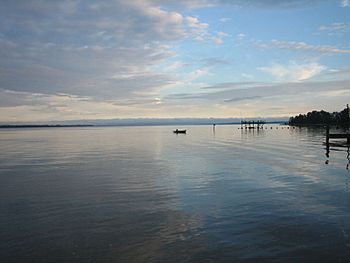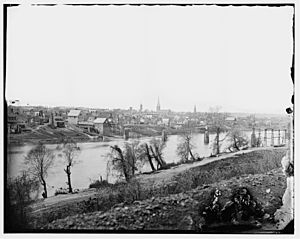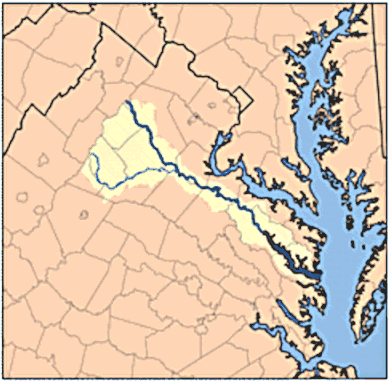Rappahannock River facts for kids
Quick facts for kids Rappahannock River |
|
|---|---|

The Rappahannock at sunset
|
|
| Country | United States |
| State | Virginia |
| Counties | Lancaster, Middlesex, Essex, Richmond, Westmoreland, King George, Caroline, Stafford, Spotsylvania, Culpeper, Fauquier, Rappahannock |
| City | Fredericksburg |
| Physical characteristics | |
| Main source | Chester Gap 1,720 feet (520 m) |
| River mouth | Chesapeake Bay |
| Length | 195 miles (314 km) |
| Basin features | |
| Basin size | 2,848 sq mi (7,380 km2) |
The Rappahannock River is a river in eastern Virginia, in the United States. It is about 195 miles (314 km) in length. It crosses the entire northern part of the state, from the Blue Ridge Mountains in the west, across the Piedmont, to the Chesapeake Bay, south of the Potomac River. The river drains an area of 2,848 square miles (7,380 km2) which is about 6% of Virginia. Much of the watershed is rural and forested. But it has experienced increased development in recent decades because it is so close to the Washington, D.C. suburbs.
It was an important river in American history. The Rappahannock was the site of early settlements in the Virginia Colony. Later, it was at the center of Eastern Theater of the American Civil War. It was a significant obstacle to north-south movements via land. As a result it functioned as the war's eastern-theatre boundary, between the "North" (the Union) and the "South" (the Confederate States of America).
History

The name of the river comes from an Algonquian word, lappihanne (also recorded as toppehannock), meaning "river of quick, rising water" or "where the tide ebbs and flows," the name used by the local native population, the Rappahannock tribe.
Although there had been a few small hamlets along the lower Rappahannock during early colonial times, the settlement of the Rappahannock River valley began in earnest during the first years of the 18th century, at the urging of Governor Alexander Spotswood. The James River had been surveyed up to its fall line, the point where, geologically, continental bedrock of the Piedmont meets the sedimentary rocks and alluvial soils of the coastal plain. Spotswood encouraged settlement in a river valley other than that of the James. In 1714, he began seeking immigrants from the Rhineland-Palatinate and Switzerland to homestead on lands he controlled near where the Rappahannock and the Rapidan came together. Known as the Germanna settlement(s), these villages were founded in order to exploit the iron ore deposits of the region.
The Battle of Rappahannock River was fought on the river during the War of 1812. Seventeen British boats filled with hundreds of marines and sailors captured four American privateers.
During the American Civil War, the river, with few convenient fords and fewer bridges, provided a barrier and defensive line. Behind this line troops had little fear of attack from the river-side. It was an especially difficult barrier for Union troops to overcome in their attempts to thrust into southern Virginia. Control of the river changed hands many times during the course of the war. Significant battles fought along the river include the Battle of Fredericksburg and the Battle of Rappahannock Station. The defensive line at the river was finally bypassed by Ulysses S. Grant in the Wilderness (or Overland) Campaign of 1864, ending in the ultimate Union victory.
In some 18th- and 19th-century documents, including some Civil War records, the Rappahannock River was referred to as "Hedgeman's River"
Description
The Rappahannock River rises at Chester Gap, a wind gap in the Blue Ridge Mountains a few miles southeast of Front Royal, Virginia. It flows southeastward before it is joined by the Rapidan River, its largest tributary, from the right. Then the Rappahannock passes through the city of Fredericksburg. Southeast of Fredericksburg, it begins to slow and widen into a brackish tidal estuary approximately 50 miles (80 km) long. It passes two small, but historic, river towns, Port Royal and Port Conway, which sit opposite each other. The former is on the south bank, the latter on the north. Then it flows past Tappahannock on its southern bank, a point where the river is well over a mile wide. The last settlements of any size before reaching the Chesapeake Bay are Irvington, Urbanna, Stingray Point, and White Stone Beach. The broad river enters the Chesapeake Bay approximately 20 miles (32 km) south of the mouth of the Potomac River and approximately 60 miles (97 km) east of the state capital, Richmond. At the point where the river enters the bay, between Windmill Point, on the north, and Stingray Point, on the south, it is more than 3.5 miles (5.6 km) wide. This area, the estuary south of the Northern Neck peninsula, is a productive oyster and crab fishery.
Above Fredericksburg, the Rappahannock provides fine opportunities for recreational canoeing and kayaking. Most of the rapids are Class I and Class II in difficulty, but, near Remington, there are some rapids that are considered to be Class III. The rivers watershed is protected in various places by parcels of the Rappahannock River Valley National Wildlife Refuge.
See also
 In Spanish: Río Rappahannock para niños
In Spanish: Río Rappahannock para niños


